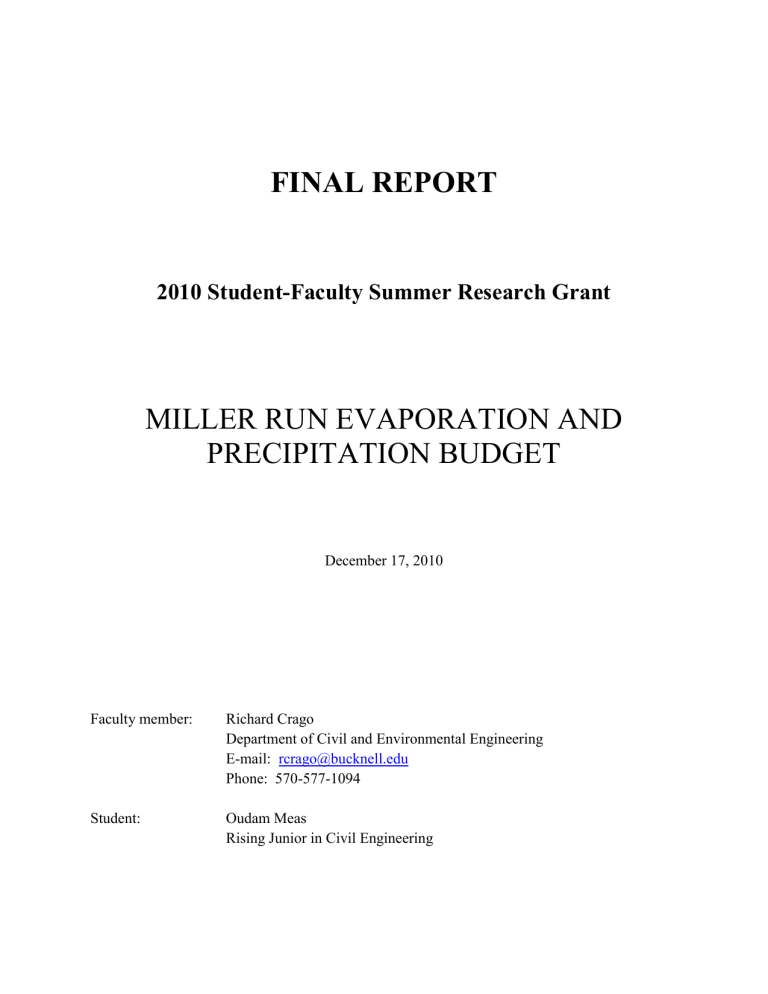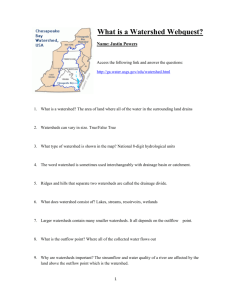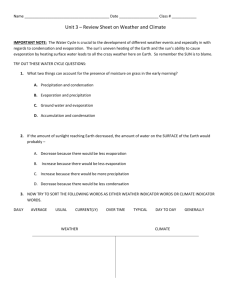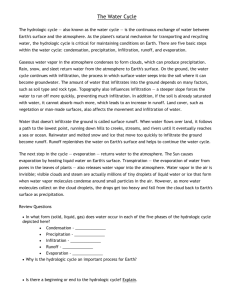Crago_water_budget_study_12_17_10

FINAL REPORT
2010 Student-Faculty Summer Research Grant
MILLER RUN EVAPORATION AND
PRECIPITATION BUDGET
December 17, 2010
Faculty member: Richard Crago
Department of Civil and Environmental Engineering
E-mail: rcrago@bucknell.edu
Phone: 570-577-1094
Student: Oudam Meas
Rising Junior in Civil Engineering
INTRODUCTION
Miller Run is a small stream with a watershed area of 2.3 km
2
(Burke et al., 2009) that passes through the Bucknell golf course and the Bucknell campus, and empties into Limestone (Bull)
Run in downtown Lewisburg. It is one of the target streams of the Susquehanna Initiative of the
Bucknell University Environmental Center (BUEC). Currently the stream is in poor ecological health, and a primary reason is that in a typical year the streambed is dry through campus during much of the summer. USGS maps indicate that Miller Run used to be a perennial stream. Three hypotheses for the dry streambed in summer are: decreased groundwater recharge due to increasing impervious areas; water is leaving the stream and entering the limestone bedrock that begins east of Rt. 15; and flow continues through the summer but is hidden beneath sediment and rip-rap that cover the actual channel bed on campus. With each of these hypotheses, the fact that there is flow through three seasons suggests that seasonal water table fluctuations most likely play a role. This study was initiated to investigate the watershed water budget, with a focus on variability in water stored within the watershed.
STUDY METHODS
Data include those available from the Bucknell weather station BUWX
( http://www.bucknell.edu/weather/Index.html
) and streamflow data collected by Schaeffer
(2008) and Burke et al. (2009). Streamflow measurements were taken at two stations along the stream, namely, upstream near Bucknell’s Art Barn, and downstream under the Art building on campus. Three different methods were used to construct the water budget for part or all of the period of record from BUWX.
First, daily averages of the meteorological variables, including radiation measurements, temperature, humidity, and wind speed were used to reconstruct the history of precipitation, evapotranspiration using the Advection-Aridity method (e.g., Crago et al., 2010), and runoff using the SCS Curve Number Methodology (e.g., Mays, 2005). Advection-aridity evaporation uses two different potential evaporation estimates to deduce the actual evaporation rate from a non-saturated surface.
The second method used the same meteorological data and Advection-Aridity for predicting evaporation, but it added streamflow data collected by Burke et al. (2009) and Schaeffer (2008).
These first two methods were used for the period April through October, 2009. Winter months were excluded because of the complications caused by snow and snowmelt. In particular, the
BUWX raingage can only measure snow when it melts, and it can only hold 6 cm of snow. Thus snowfall can be greatly underestimated.
The final method used was a Thornthwaite-type simple water balance model run on a monthly time step (Dingman, 2002 a,b). Monthly average air temperature and monthly total precipitation depths from 2007 to 2009 were averaged to provide a single composite year of monthly data.
The model tracked snow, rain, snowmelt, changes in soil moisture, and evaporation monthly for the composite year. The model was also run using long-term average temperature and precipitation data from the Selinsgrove weather station
(http://www.idcide.com/weather/pa/selinsgrove.htm).
RESULTS AND DISCUSSION
The water budget results using the first method are given in Figure 1 for two of the years studied.
Table 1 shows cumulative values of the water budget terms for each year, for the April through
October period. In half the years, estimated evaporation exceeded precipitation, and the average
evaporation over the six years was 490 mm compared to an average precipitation of 540 mm. As a result, water stored in the watershed was calculated to decrease in most years [for example, by some 250 mm in 2008 (see Figure 1b)]. If these data are correct, it would imply substantial fluctuations in the water table which could result in greatly reduced baseflow or even no flow (if the water table dropped below the bed of the channel). Lake evaporation estimated from an evaporation pan at Raystown Lake ( http://climate.met.psu.edu/features/other/evap/evap.php
) averages around 590 mm over the same period, which is slightly higher than the average actual evaporation estimate with this method of 491 mm. Thus the computed actual evaporation estimates from the Advection-Aridity model are certainly realistic. The long-term average precipitation measured at Selinsgrove for the same months is 681 mm, which is significantly greater than the average of 546 mm measured here. Missing data, which cannot be reliably filled by interpolation, are one reason for the discrepancy. However, it seems likely that rainfall in the watershed during most of the years studied has been below the long-term average.
The role of impervious areas can be investigated with this method by comparing the estimated cumulative infiltration depths over the 2009 growing season for the upstream and the downstream watershed. The upstream watershed has few impervious surfaces and has a curve number of CN=77, while the downstream watershed, which contains the Bucknell campus, has a curve number of 79. To illustrate the increase in impervious area, this amounts to an increase in average impervious area in the range of 3 to 5 percent. This increase in impervious area resulted in a decrease in infiltration from 487 mm to 394 mm, or about 19 percent. Runoff increased by this same amount. The decreased infiltration results in less water to evaporate and less water to recharge groundwater and provide baseflow. Campus is much more impervious than the watershed as a whole, approaching 40% impervious, and would therefore have much greater runoff and reduced infiltration. Because infiltration contributes to soil moisture storage
(resulting in evaporation) as well as to recharge of the groundwater, the cumulative infiltration depth cannot be directly related to changes in water table depth.
To further investigate the water balance using the second method, streamflow data were included in the water budget for 2009, as shown in Figure 2. Notice that both evaporation and streamflow exceeded precipitation in the upstream watershed, while streamflow ceased for much of the summer at the Art Building on campus (bottom panel). Having both evaporation and streamflow exceed precipitation seems unlikely for the entire growing season. A possible explanation is that the rating curves established at the gaging stations by Schaeffer (2008) are not accurate for the full range of flow rates encountered. It is especially difficult to establish accurate rating curves for either very low flows, such as those that occurred for much of the summer, or for major runoff events. At the downstream station, cumulative runoff was nearly double the cumulative streamflow, while for the upstream gage the streamflow was much higher than the runoff. The greater impervious area of the downstream watershed plays some role in this, but the dramatic difference in the cumulative streamflows is hard to explain unless there are some measurement errors.
It appears that reliable quantitative streamflow estimates are not available with the data and rating curves used here. However, the data are certainly accurate enough to identify times of no flow and response times to rainfall events.
The third method used a simple conceptual water balance model (Dingman, 2002 a,b). To minimize problems due to missing data, precipitation during each month was averaged over a three year period from 2007 to 2009. It is acknowledged that snowfall is likely to be
underestimated. The results in Figure 3 show that moisture in the soil is greatly depleted during the summer (note the decrease in the curve for the SOIL variable). The water stored in the soil was at its maximum allowable level of 100 mm in March and April, but dropped to only 9 mm in
August. In this simulation excess water that can recharge groundwater or provide runoff (shown as W-ET-ΔSOIL on the graph) is available during only two months of the year, totaling 227 mm.
To investigate whether unusually low summer precipitation played a major role during the measurement period, a new simulation was done using climatological data from the Selinsgrove weather station. Results are shown in Figure 4. Note that soil moisture is only slightly depleted in summer, and W-ET- ΔSOIL is above zero for six months of the year, totaling 421 mm. To determine if the known errors in BUWX winter precipitation measurements had a significant effect, the climatological data were used in a third simulation. However, in this one, the threeyear composite precipitation from BUWX was used instead of the climatological data for the months of January, February, March, and December. Results are shown in Figure 5. Note that
W-ET- ΔSOIL is again above zero for six months of the year, totaling 368 mm. While the water available for streamflow is lower than that for the climatological data, the water stored in the soil layer (SOIL) does not drop any lower in the summer than it did with the climatological data.
This suggests that streamflow during the summer is not excessively impacted by underestimated winter precipitation. Instead, the primary reason the soil dries out is lower than average precipitation during the summer.
A rough estimate with this model of the impact of the fraction of impervious surfaces in the watershed (I) on the water budget with the long-term average data can be given by assuming that the model handles pervious surfaces properly but all water falling on impervious areas runs off.
Thus impervious surfaces will have no evaporation so ET must be multiplied by (1-I) to give the watershed average evaporation. Table 2 shows the results of increasing impervious areas. It is clear that streamflow will increase as the impervious area increases, because less water will be
“lost” to evaporation. However, as impervious area increases, a larger fraction of the streamflow will consist of runoff, while other excesses (primarily groundwater recharge) will decrease. As the impervious fraction increases from 0 to 0.4 (comparable to Bucknell’s campus), the amount of water available for groundwater recharge decreases from 39% of precipitation to 24% of precipitation. The difference in mm is 168 mm of water.
CONCLUSIONS
1.
Streamflow data collected by students in 2008 and 2009 are useful for qualitative studies, but reliable quantitative measurements for the full range of flows were not obtained.
2.
Multi-year averages of evaporation estimates using the theoretically-based Advection
Aridity method (491 mm) and using Thornthwaite’s empirical equation embedded in the monthly water balance method (463 mm) were quite similar for the months of April through October, giving confidence that this term of the energy budget is reasonable.
3.
Precipitation measurements from BUWX are known to be underestimated during the winter. This known error was avoided in the first two methods of estimating the water budget, since winter measurements were not included. The average seven-month
cumulative precipitation from BUWX of 546 mm is significantly below the long term average of 681 mm.
4.
The monthly water budget model results suggest that low rainfall during recent years likely has led to significantly less moisture in the soil during the summer and less recharge to the groundwater, reducing baseflow in the summer.
5.
Increasing impervious area leads to significantly less recharge to the groundwater, while increasing runoff during storm events.
6.
Decreasing summer rainfall and increasing impervious areas combine to produce larger than usual fluctuations in the water stored in the watershed.
7.
Although this study confirmed that storage within the watershed varies considerably with season, it is impossible to conclude from the data or models whether water table fluctuations alone cause the flow to cease during summers, or if the underlying geology or the sediment and rip-rap in the channel bed also contribute to the problem.
REFERENCES
Burke, M., Lamancusa, C., Clarke, J., Gjerdingen, O., Elmanakhly, Z., Gornto, J., Jurenovich,
K., Lipiec, E., Ramseyer, B., Cooper, B., Koch, K., and Tomtishen, J., Characterization of
Miller Run and Conceptual Plan for Watershed Restoration , Final Report for a Class Research
Project in UNIV 298, Advisors, R.C. Kochel and M. McTammany, Bucknell University, 2009.
URL: http://www.departments.bucknell.edu/environmental_center/StreamRestorationCourse/Projects.h
tml
Crago, R. D., R. J. Qualls, and M. Feller (2010), A calibrated advection-aridity evaporation model requiring no humidity data, Water Resour. Res., 46, W09519, doi:10.1029/2009WR008497.
Dingman, S. L., Physical Hydrology, 2 nd
Edition , Waveland Press, Long Grove, IL, 2002 a.
Dingman, S. L., CD included with Physical Hydrology 2 nd Edition , Waveland Press, Long
Grove, IL, 2002 b.
Mays, L., Water Resources Engineering , 2005 Edition, Wiley, Hoboken, NJ, 2005.
Schaeffer, A., Hydrologic and Water Quality Assessment of Miller Run: A Study of Bucknell
University’s Impact , Bucknell University Honor’s Thesis, 2008.
Table 1. Cumulative Water Budget Amounts for April through October using method 1. P is precipitation, E is evaporation, R is runoff, and I is infiltration.
Year
2008
2009
P
(mm)
E (mm)
963 555
R (mm)
191
I (mm)
772 2004
2005 462 517
2006 547 512
2007
*
314 406
462
528
468
489
73
160
37
68
84
389
387
277
394
444
Average 546 491 102 444
*
Due to missing data, the month of July was excluded from calculations in 2007.
Table 2. Impact of impervious areas on Thornthwaite water balance (in watershed mm) using climatological weather data. P is precipitation and ET is evapotranspiration.
Imperv. Fraction, I
P
ET
Runoff/recharge
Imperv. Runoff
Other excess*
0 0.1 0.2 0.3 0.4
1069 1069 1069 1069 1069
648 583.2 518.4 453.6 388.8
421 485.8 550.6 615.4 680.2
0 106.9 213.8 320.7 427.6
421 378.9 336.8 294.7 252.6
* Other excess could be either runoff from pervious surfaces or recharge.
1200
1000
2004
800
600
400
200
334,772
Cumulative P
Cumulative E
Cumulative Runoff
Watershed storage
Cumulative Infiltration
0
-200
4-Mar 23-Apr 12-Jun 1-Aug 20-Sep 9-Nov 29-Dec
Time (date)
600
500
400
300
200
100
2008
0
-100
12.апр 01.июн 21.июл 09.сен 29.окт 18.дек
-200
P accumulated
E accumulated
Runoff accumulated
Deta S accumulated
Infiltration
-300
Time (date)
Figure 1. Cumulative water budgets for April through October. The top panel is a water budget for 2004, a very moist year. The bottom panel is a water budget for 2008, a dry year. Units are mm of water. This can be converted to a volume by multiplying by the watershed area. P is precipitation, E is evaporation, and Deta S and watershed storage are both the mm of water stored within the watershed.
600
500
400
2009--Upstream; CN=77
depth
(mm)
300
200
100
0
06.фев
-100
28.мар 17.май 06.июл 25.авг 14.окт
P
E
Runoff
Groundwater storage
Streamflow
03.дек
-200
600
500
400
300 depth
(mm)
200
100
0
06.фев
-100
-200
28.мар
2009-Downstream; CN=79
17.май 06.июл 25.авг 14.окт
P
E
Runoff
Groundwater storage
Streamflow
03.дек
Figure 2. Cumulative water budgets for April through October, 2009, including streamflow measurements. Units are mm of water. The top panel is for the upstream watershed, and the bottom panel is for the downstream watershed. P is precipitation, E is evaporation, and groundwater storage is the water stored within the watershed.
MONTHLY WATER BALANCE--3 year composite data
180
160
140
120
P
PACK
W
100
80
60
40
20
SOIL
ET
W - ET -
/\SOIL
0
0 2 4 6 8
MONTH
10 12 14
Figure 3. Annual water budget on a monthly time step using temperature and precipitation data measured with BUWX, averaged over a three year period from 2007 to 2009. Maximum soil storage was set at 100 mm. P is precipitation, PACK is the depth of liquid water in the snow pack, W is water available at the soil surface, SOIL is the amount of water stored in the soil layer, ET is evapotranspiration, and W-ET-ΔSOIL is the excess water that can be either runoff or recharge the groundwater.
MONTHLY WATER BALANCE--Climatological Average Data
100
80
60
40
20
200
180
160
140
120
P
PACK
W
SOIL
ET
0
0 2 4 6 8
MONTH
10 12 14
Figure 4. Annual water budget on a monthly time step using climatological monthly average temperature and precipitation data measured in Selinsgrove, PA. Maximum soil storage was set at 100 mm. Variable names are the same as in Figure 3.
250
200
150
100
50
MONTHLY WATER BALANCE--Climatological data except for winter precipitation
P
PACK
W
SOIL
ET
W - ET -
/\SOIL
0
0 2 4 6 8
MONTH
10 12 14
Figure 5. Annual water budget on a monthly time step using climatological montly average temperature and precipitation data measured in Selinsgrove, PA, except the precipitation data during January, February, March, and December is the same as the data used in Figure 3.
Maximum soil storage was set at 100 mm. Variable names are the same as in Figure 3.







